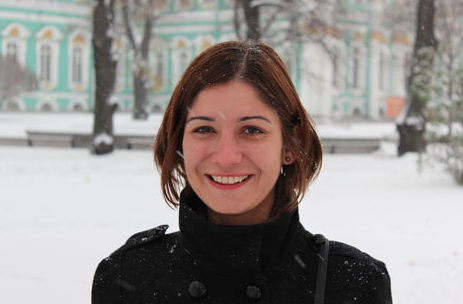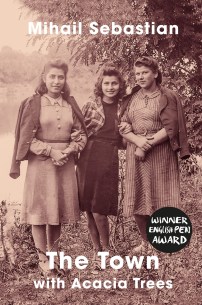
Gabi Reigh was born in Romania and moved to the UK in her teens. Her translations and fiction have been published in Modern Poetry in Translation, World Literature Today and The Fortnightly Review. She has won the Stephen Spender prize for poetry in translation and was shortlisted for the Tom-Gallon Society of Authors short story award.
„Our literary traditions are little known outside our countries, and are often placed in a position of cultural and geographic marginality. So when I learned about Gabi’s project to translate inter-war Romanian literature, I wanted to find out more.
After studying and teaching English literature for over twenty years, Gabi began translating Romanian literature. Her translation of The Town with Acacia Trees by Mihail Sebastian was the first novel translated from Romanian to win a PEN Translates award in 2019 and the opening chapters of Liviu Rebreanu’s Ciuleandra were longlisted in the John Dryden translation competition. As well as translating interwar classics, Gabi is keen to introduce the work of contemporary female poets to an English speaking audience. Her translations and articles have appeared in Modern Poetry in Translation, World Literature Today, New Eastern Europe, and openDemocracy. Reading in Translation reviewed her translation of Lucian Blaga’s Poems of Light”.
Why did you decide to translate interwar Romanian literature?
Gabi Reigh: My first attempt at translation was a poem called “The Traveller,” by Marin Sorescu. After it won the Stephen Spender poetry translation competition I realized that I wanted to translate more Romanian literature. I began with a poetry collection that I have always loved and that means a great deal to a lot of Romanian people, Poems of Light, by Lucian Blaga (1919). After that, I started thinking about other books that I had heard about at school or seen on my parents’ bookshelf when I grew up in Romania and realized that they were all written in the interwar period. So I decided to embark on the “Interbellum Series” project and make canonical works by writers such as Mihail Sebastian, Liviu Rebreanu and Hortensia Papadat-Bengescu accessible to an English speaking public.
I realized that while these classics were well known in Romania and considered a part of our literary heritage, most people in the English speaking world would never have heard of them. The interwar period was an intellectually fertile era in Romanian culture, but it was mostly the Romanian artists that emigrated to the US or France (such as Mircea Eliade, E.M.Cioran, Eugen Ionesco or Constantin Brancusi) who achieved international acclaim.
Why do you think it’s important that these works are translated into English?
Gabi Reigh: I was listening to a BBC Radio 4 series called “As Others See Us,” where the art historian Neil Macgregor interviewed people from countries such as Poland, India and Spain about how they saw Britain. Several interviewees reported that their first introduction to British culture was through reading its literature in translation. Their exposure to the works of William Shakespeare and Virginia Woolf not only allowed them to connect to those particular British writers and discover that they experienced the same existential concerns that they did, but also created in their minds an image of Britain as a place with a robust intellectual tradition.
I feel that in the English speaking world we are largely familiar with the literary canon of Western European countries and this has created a certain respect for their cultures. Flaubert, Proust, Camus, Mann, Dante, Cervantes would feature on every educated person’s list of books they ought to read. On the other hand, there are many other countries around the world, including Romania, who have a rich literary past which is yet to be discovered abroad.
There are around 10 million Romanian people now living in various places around the world and it would be a wonderful thing if the native populations of their host countries could begin to understand these people better by having access to their literature. Also, many of the Romanian emigres will have children whose first language will be English and I wanted this new generation to have the ability to read these books in order to connect with their cultural heritage.
What do these works teach us about Romania?
Gabi Reigh: I think the novels evoke the atmosphere of Romania, as they mention little details from everyday life that I remember from my time there, such as the evening promenades through the town centre or reading in front of a terracotta stove. They also engage with the changes that were taking place in the social structures of the country at the beginning of the twentieth century. But the texts I have chosen to translate are special to me because they have a universal quality, they deal with situations and states of mind that would also be recognizable to anyone outside Romania.
I have noticed that many of the non-Western European books that have been recently translated into English tend to reinforce the popular image of the country from which they originate. For example, these might be books by writers from the former Yugoslavia about their experience of the war, South American novels about the legacy of dictatorships or Middle Eastern novels about the position of women in post-colonial societies. I love reading these novels and I think they provide an essential insight into different lives and societies.
But I think that they also reinforce the idea that the people living in those countries are essentially “other,” that their experiences are different from those of the British or American reader. The works that I chose to translate from Romanian interwar literature focus on characters who fall in and out of love, worry about the passing of time, about death and loss – in the same way that people, in any period of history, in any part of the world, have always done. I don’t think that people reading them should expect to find anything particularly “Romanian” about these books – they are just artistically accomplished meditations on what it means to be human, just like Flaubert’s or Woolf’s novels.
The first two novels you translated are by Mihail Sebastian. What drew you to his work?
Gabi Reigh: In Romania, Sebastian is best known as a playwright and for novels such as The Town with Acacia Trees and The Accident. However, my first encounter with his work was through reading his Journal and Philip O’Ceallaigh’s translation of For Two Thousand Years, both of which deal with his experiences of anti-semitism under the Iron Guard. I was utterly captivated by his voice, by his refusal to define himself as a victim and his determination to carve out a normal life for himself and continue to develop as an artist in the midst of such turbulent times.
Sebastian was part of the Criterion group, a hub of intellectuals including Mircea Eliade, Eugene Ionesco and E.M. Cioran, yet he was sadly ostracized by the nationalistic members of that group. Yet despite all these setbacks, he clung on to his humane artistic vision and produced the works he is best known for in Romania, sensitively observed novels and plays that deal with every aspect of human experience.
The Town with Acacia Trees is the first of Mihail Sebastian’s books to be published by Aurora Metro Books this fall. What is this novel about?
 Gabi Reigh: It is a witty, lyrical coming-of-age novel focusing on a young woman, Adriana, growing up in a provincial town. It is strikingly modern in its portrayal of female sexuality (including homosexuality) and evocative in its depiction of 1930s Europe. Sebastian skillfully employs two focalizers in the novel––Adriana and her lover, Gelu––thereby shifting our sympathies from one character to another.
Gabi Reigh: It is a witty, lyrical coming-of-age novel focusing on a young woman, Adriana, growing up in a provincial town. It is strikingly modern in its portrayal of female sexuality (including homosexuality) and evocative in its depiction of 1930s Europe. Sebastian skillfully employs two focalizers in the novel––Adriana and her lover, Gelu––thereby shifting our sympathies from one character to another.
Part of the charm of the novel is also its cast of minor characters––a wayward student constantly cooking up crazy schemes, a famous composer prone to compulsive lying, a society beauty who transforms into the staid wife of a nouveau riche industrialist––creating vivid, satirical social portraits reminiscent of the writing of Jane Austen or E.M. Forster.
RinT: What are your next projects?
 Gabi Reigh: My translation of Mihail Sebastian’s Women will be published next spring by Aurora Metro. It is a novel in four parts, each named after a different woman that had passed through the life of the protagonist, Stefan Valeriu. Later next year, Ciuleandra by Liviu Rebreanu will be published by Cadmus Press. It is a psychological thriller set in an asylum where a young aristocrat who has murdered his wife attempts to make sense of the events that lead to his actions.
Gabi Reigh: My translation of Mihail Sebastian’s Women will be published next spring by Aurora Metro. It is a novel in four parts, each named after a different woman that had passed through the life of the protagonist, Stefan Valeriu. Later next year, Ciuleandra by Liviu Rebreanu will be published by Cadmus Press. It is a psychological thriller set in an asylum where a young aristocrat who has murdered his wife attempts to make sense of the events that lead to his actions.
I am also in the process of translating the novel A Bach Concert by Romania’s most important female modernist, Hortensia Papadat-Bengescu as well as one of Sebastian’s best known plays, A Star Without A Name. I met a Romanian director living in London who said he would be interested in putting on this play if I translated it, so I’m excited about the prospect of it coming to life in front of an audience.
Stiliana Milkova, editor, Reading in Translation



